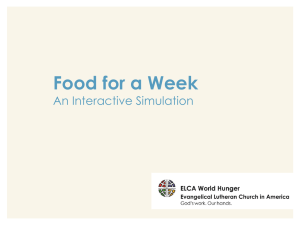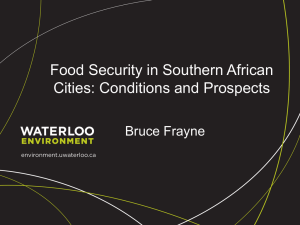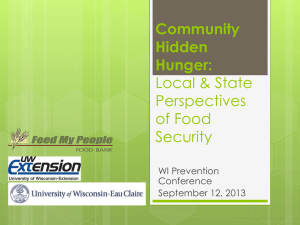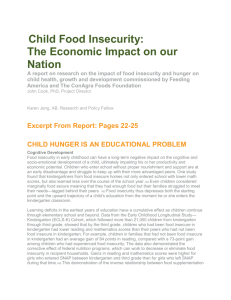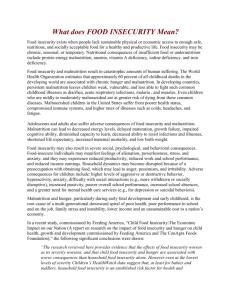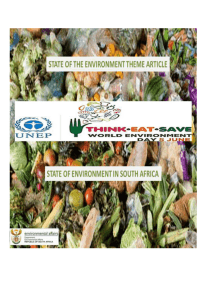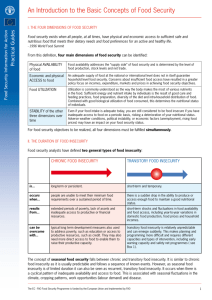DP 1083-96 - Institute for Research on Poverty
advertisement
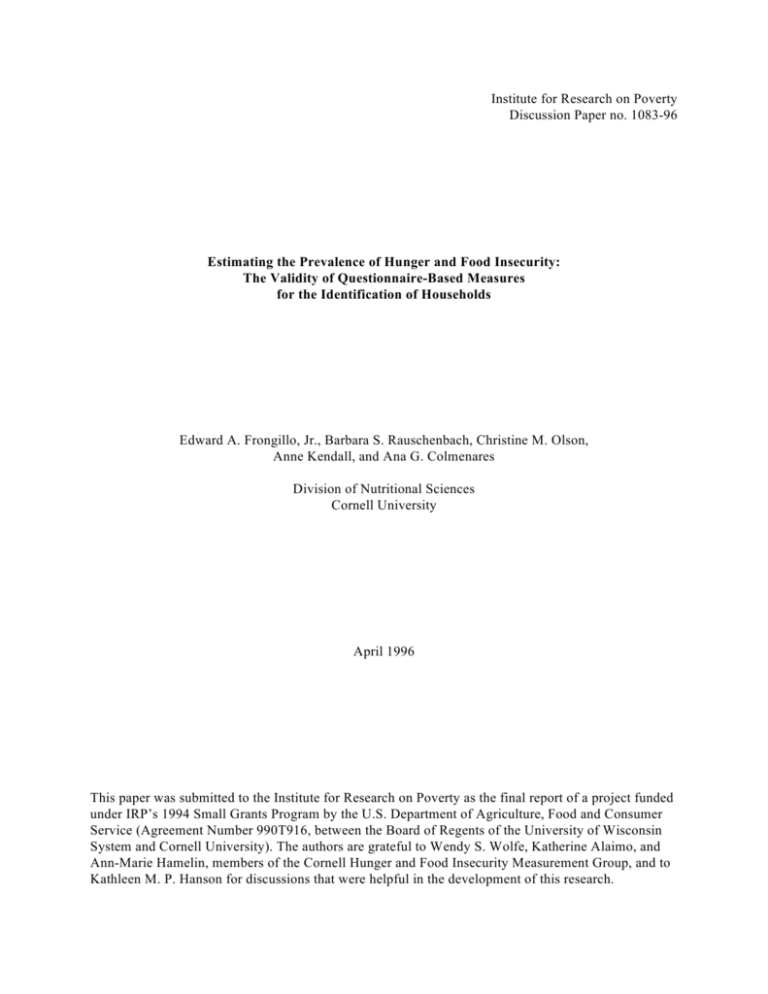
Institute for Research on Poverty Discussion Paper no. 1083-96 Estimating the Prevalence of Hunger and Food Insecurity: The Validity of Questionnaire-Based Measures for the Identification of Households Edward A. Frongillo, Jr., Barbara S. Rauschenbach, Christine M. Olson, Anne Kendall, and Ana G. Colmenares Division of Nutritional Sciences Cornell University April 1996 This paper was submitted to the Institute for Research on Poverty as the final report of a project funded under IRP’s 1994 Small Grants Program by the U.S. Department of Agriculture, Food and Consumer Service (Agreement Number 990T916, between the Board of Regents of the University of Wisconsin System and Cornell University). The authors are grateful to Wendy S. Wolfe, Katherine Alaimo, and Ann-Marie Hamelin, members of the Cornell Hunger and Food Insecurity Measurement Group, and to Kathleen M. P. Hanson for discussions that were helpful in the development of this research. Abstract This study had three objectives: (1) to assess the validity of questionnaire-based measures in identifying households experiencing hunger and food insecurity, (2) to examine the interrelationships of different questionnaire-based measures, and (3) to examine the construction of a continuous food insecurity scale intended to differentiate three levels of food insecurity within households. A 1993 survey of 193 randomly sampled rural households with women and children living at home provided data on demographics, risk factors for food insecurity, Radimer/Cornell, CCHIP, and NHANES III hunger and food insecurity items, coping strategies, fruit and vegetable consumption, disordered eating behaviors, height, weight, dietary recall, and household food-stores inventory. This information was used to develop a definitive criterion measure for hunger and food insecurity, against which the Radimer/Cornell and CCHIP questionnaire-based measures, the NHANES III item, and the continuous food insecurity scale were tested for their specificity and sensitivity in measuring levels of food insecurity. Estimating the Prevalence of Hunger and Food Insecurity: The Validity of Questionnaire-Based Measures for the Identification of Households INTRODUCTION The percentage of Americans with incomes less than the poverty threshold increased during the 1980s and domestic hunger and food insecurity reemerged as a social and political problem. The approaches that have commonly been used to estimate the prevalence of hunger and food insecurity have relied upon indirect indicators, such as the percentage of the population in poverty and/or the percentage of individuals receiving food stamps. An evaluation by the U.S. General Accounting Office (1986) criticized these approaches for not measuring hunger directly. Research was undertaken at Cornell University based upon the conviction that hunger and food insecurity can be measured directly, although some have questioned this possibility (see Margen and Neuhauser, 1987, p. 30). Because the phenomena of hunger and food insecurity are not well understood, a naturalistic paradigm was chosen to construct a theory of hunger and food insecurity grounded in the expression of people who actually experience it (Radimer et al., 1990, 1992; hereafter, these measures are denoted as the Radimer/Cornell measures). This research concluded that: (1) food insecurity is experienced differently at the household, adult, and child levels, (2) food insecurity has four components, and (3) hunger is the most extreme consequence of the progression of food insecurity. Two components of food insecurity, quantity and quality of food, are related directly to food. Two other components, certainty and acceptability, are psychological and social in nature. The literature on hunger and food insecurity (e.g., Maxwell and Frankenberger, 1992) supports this theory. In January 1994, the Food and Nutrition Service of the United States Department of Agriculture (USDA) and the National Center for Health Statistics (NCHS) convened a one-day conference entitled “Food Security Measurement and Research.” The two objectives of this conference were: (1) to determine and recommend a current state-of-the-art survey instrument; and (2) to develop and 2 recommend a comprehensive research agenda. A smaller workshop the next day focused on the design of “survey items for a questionnaire module to measure food security and its related elements.” From this conference and workshop emerged a consensus that it was crucial to be able to measure and estimate the prevalence of hunger and food insecurity in the United States. In the next year, USDA, the National Center for Health Statistics (NCHS), and the Bureau of the Census together developed a module for measuring hunger and food insecurity, implemented in the April 1995 Current Population Survey (CPS). The module was based upon questionnaire items that draw from the Radimer/Cornell measures, the Community Childhood Hunger Identification Project (CCHIP) surveys, previous USDA and NCHS surveys, and other sources. The most critical issues that remain unresolved are: (1) how various survey items constructed from diverse concepts and formats can be combined to yield valid measures of hunger and food insecurity, and (2) how estimates of the prevalence of hunger and food insecurity should be derived from these measures. The Cornell Hunger and Food Insecurity Measurement Group has continued research on these topics, with objectives that included: 1. Developing a set of principles as a foundation for determining the validity of measures of hunger and food insecurity and estimates of its prevalence (Frongillo, 1994; Olson et al., 1994); 2. Further analyzing the construction of measures of hunger and food insecurity based on the Radimer/Cornell items and assessing their validity and reliability (Kendall et al., 1994, 1995b); 3. Assessing the validity of measures combined from Radimer/Cornell and CCHIP items for estimating the prevalence of hunger and food insecurity for the CPS module (Olson et al., 1994); and 4. Assessing whether traditional dietary measures of household food availability and individual food intake are indicative of hunger and food insecurity in a food-rich context (Kendall et al., 1995a). 3 This paper reports on results for three objectives that have built upon this work. First, we assessed the validity of the questionnaire-based measures for identifying households experiencing hunger and food insecurity, in order to estimate prevalence and achieve better targeting and screening of needy families. Second, we examined the interrelationships of the questionnaire-based measures of food sufficiency—Radimer/Cornell, CCHIP, and the Third National Health and Nutrition Examination Survey (NHANES III)—in order to strengthen our ability to interpret these available measures. Third, we examined the construction of a continuous food insecurity scale. USDA has previously expressed the desire to have a single measurement scale that can differentiate three levels of food insecurity that are of interest and policy relevance: food insecurity short of actual hunger, adult hunger within the household, and severe (child) hunger within the household. Our previous work identified items from the Radimer/Cornell questionnaire and the CCHIP questionnaire that were strongly related at the group level to social, economic, and demographic factors (e.g., income, employment, education, use of food programs), and that yielded consistent prevalence estimates with a low rate of false negatives (Olson et al., 1994; Kendall et al., 1995b). In this paper, we report on the rate of false positives (i.e., those who reported hunger and food insecurity but who did not actually experience it), and provide information about discrepancies among the Radimer/Cornell, CCHIP, and NHANES III food sufficiency items. In addition, we report on the convergence of prevalence estimates based upon the groupings developed from the questionnaire-based measures with prevalence estimates based upon a more definitive measure of hunger and food insecurity that was developed by examining the complete set of information available for each respondent in our 1993 survey. From this information we were able to construct a definitive criterion measure for food insecurity at the household level. We are continuing work aimed at evaluating prevalence estimates of hunger and food insecurity from questionnaire-based measures at the individual level. 4 METHODS Data Data were collected in a survey of households containing women with children living at home, conducted between January and July of 1993 in a rural county of New York State. The sample for the survey was randomly selected from a database gathered three years previously as part of a health census of the county. Women 40 and older and those with 16 or more years of education were excluded from the sampling frame; 3,433 women were eligible for selection into the sample. A sample of approximately 200 households was desired, because a 1988 survey using the Cornell measures had found statistically significant relationships between the measures and risk factors for hunger and food insecurity with a sample size of 189. Disproportionate random sampling was done within thirty strata defined by socioeconomic status (six groups) and age (five groups) in order to ensure adequate representation of those most at risk. In order to allow for those who refused to participate or who could not be located, a pool of 639 potential subjects was selected from the health census. Fifty-two percent of the women (331) no longer lived at the address given during the health census, and could not be located within the county.1 Of the remaining 308 women, 35 percent refused participation in the survey, resulting in a sample of 200 women.2 Because only seven of the 200 women fell into the youngest age group (15–19 years), they were dropped from the analysis, yielding a final sample of 193. Two interviews, separated by approximately three weeks, were conducted with each respondent. During the first interview, a survey designed to elicit demographic information, 1 We were unable to locate 66 percent in the ten most at-risk demographic strata, 56 percent in the 15 moderately at-risk strata, and 31 percent in the five least at-risk strata. 2 The refusal rate was 18 percent in the ten most at-risk strata, 40 percent in the 15 moderately at- risk strata, and 32 percent in the five least at-risk strata. 5 information on risk factors for food insecurity, use of coping strategies, and containing the Radimer/Cornell, CCHIP, and NHANES III hunger and food insecurity items was administered to each study participant by trained field workers. All of the Radimer/Cornell items (Table 1) were expressed as statements, in line with recommendations that arose out of the previous survey using these items (Radimer et al., 1990). The possible responses to the Radimer/Cornell items were “not true,” “sometimes true” or “often true.” Any subject answering “sometimes true” or “often true” to any item within a measure was categorized as food insecure. CCHIP items (Table 1) were administered as questions with no/yes answers following the description in Wehler et al. (1992). The NHANES III item administered was: “Which one of the following statements best describes the food eaten by your family? Do you have: 1. enough food to eat, 2. sometimes not enough to eat, or 3. often not enough to eat” (Briefel and Woteki, 1992). During the first interview, questions about the frequency of fruit and vegetable consumption were administered, along with four questions about food consumption patterns indicative of disordered eating behaviors from the Stanford Eating Disorders Questionnaire (Agras, 1987). Each subject's height and weight were measured during the first interview. At both interviews, a 24-hour recall was taken and household food stores were inventoried. The inventory tool contained 51 food items with four quantitative response categories, with 1 indicating none of the food present and 4 that a large amount was present. The response categories were determined by the weight or volume of the item when purchased and by judgments of meaningful differences that would differentiate those with depleted food stores from those with replete food stores. 6 TABLE 1 Radimer/Cornell and CCHIP Hunger and Food Insecurity Items, with the Percentage of the Sample Responding Affirmatively to Each Cornell Item CCHIP Item % Responding Affirmatively Household-Level Insecurity Food Uncertainty Component (a) I worry whether my food will run out before I get money to buy more x (b) Does your household ever run out of money to buy food? In the past 30 days? 5 or more days in the past 30 days? 39.0 x Qualitative Component (c) We eat the same thing for several days in a row because we only have a few different kinds of food on hand and don't have money to buy more x (d) Do you ever rely on a limited number of foods to feed your children because you are running out of money to buy food for a meal? In the past 30 days? 5 or more days in the past 30 days? 35.1 11.1 5.0 25.3 x 32.6 12.9 5.1 Quantitative Component (e) The food that I bought didn't last and I didn't have money to buy more x 22.3 (f) I ran out of the foods that I needed to put together a meal and I didn't have money to get more x 29.6 Qualitative Component (g) I can't afford to eat properly x 23.2 Quantitative Component (h) I am often hungry but I don't eat because I can't afford enough food x 9.8 (i) I eat less than I think I should because I don't have enough money for food x 14.8 Individual-Level Insecurity (table continues) 7 TABLE 1, continued Cornell Item (j) Do you ever cut the size of meals or skip because there is not enough food in the house? In the past 30 days? 5 or more days in the past 30 days? (k) Do you ever eat less than you should because there is not enough money for food? In the past 30 days? 5 or more days in the past 30 days? Child Qualitative Component (l) I cannot give my child(ren) a balanced meal because I can't afford that CCHIP Item % Responding Affirmatively x 24.0 11.7 5.9 x 23.7 12.5 6.1 x 15.1 Quantitative Component (m) My child(ren) are not eating enough because I just can't afford enough food x 7.1 (n) I know my child(ren) are hungry sometimes, but I just can't afford more food x 8.5 Child Hunger (o) Do your children ever eat less than you feel they should because there is not enough money for food? In the past 30 days? 5 or more days in the past 30 days? (p) Do your children ever say they are hungry because there is not enough food in the house? In the past 30 days? 5 or more days in the past 30 days (q) Do you ever cut the size of your children's meals or do they ever skip meals because there is not enough money to buy food? In the past 30 days? 5 or more days in the past 30 days? (r) Do any of your children ever go to bed hungry because there is not enough money to buy food? In the past 30 days? 5 or more days in the past 30 days? x 13.1 6.6 2.3 x 7.0 5.0 2.8 x 6.3 4.3 2.8 x 0.8 0.0 0.0 8 Development of a definitive criterion measure. A measure is considered valid if it is precise, dependable, and accurate for a particular purpose and context. The hierarchy of possible measures includes definitive, reference, and field (Uriano and Cali, 1977). Definitive measures achieve high accuracy because they rely on first principles, i.e., they reflect in a fundamental way the theoretical structure of the phenomena they purport to represent. Definitive measures must be extremely precise and dependable. Reference measures achieve accuracy because they directly and closely relate to the phenomena of interest, and accuracy is demonstrated by comparison to definitive measures. Reference measures must be highly precise and dependable. Field measures are usually fast and inexpensive, and require relatively unsophisticated personnel; accuracy is demonstrated by comparison to reference measures. Field measures must be adequately precise and dependable. The most definitive measure of hunger and food insecurity would be based upon an evaluation of a household's food situation through a personal, in-depth interview with a household member conducted by a skilled and knowledgeable interviewer. The household’s hunger and food insecurity status would be made classified according to the following standard: Would a reasonable person conclude that the household was insecure, considering the generally accepted definition of food insecurity (certainty, acceptability, quality, and quantity of food)? A skilled and knowledgeable interviewer would also be able to determine who in the household was affected by hunger and food insecurity, and to what degree. The data available from the 1993 Cornell survey provided the opportunity to develop an approximation to this most definitive measure. We adapted a consensus method used previously by the first author to approximate the clinical assessment of growth faltering in children (Frongillo et al., 1990). Two researchers with significant but very different experiences related to hunger and food insecurity examined the survey information available for the 193 households in the 1993 survey. One researcher, from a developing country, has studied the consequences of food insecurity and other 9 factors for child growth and health. The other researcher, from the United States, has studied food insecurity among elderly persons and soup kitchen guests. Both researchers had access to responses to questions from the entire interview, except for the Radimer/Cornell, CCHIP, and NHANES items. Extensive information on the use of food programs, sources of and expenditures on food and on other items, and income, were available from the survey, as were two 24-hour dietary recalls and two household food inventories. After reviewing about 15 interview folders, one researcher selected all the variables that were thought to be related to food insecurity and that could be easily deciphered if codes were printed out from a computerized file. The 24-hour dietary recalls and answers to open-ended responses were also included. Working independently, each researcher determined for each household whether or not it experienced hunger and food insecurity, while blind to the questionnaire-based items intended to measure hunger and food insecurity. The major positive and negative risk factors for food insecurity are presented in Table 2; starred factors were weighed more heavily. The order of risk factors corresponded to that found in the interviews and was followed by the researchers in evaluating the households. The 24-hour-recall information was evaluated last. For each household, the researchers determined whether or not the household was food insecure from a cumulative consideration of the information available. No attempt was made to determine either the severity of hunger and food insecurity or the level (whether household or individual, adult or child). After several households were classified, it was clear that three rather than just two categories were needed: definitely food secure, definitely food insecure, and probably food insecure. The last category was established for households that exhibited some characteristics of food insecurity but had not clearly experienced food insecurity in the past year. Midway through the classification of the 193 households, the researchers discussed the interpretation of the available information (e.g., accuracy of food expenditure data) with the members 10 TABLE 2 Major Risk Factors in the Development of the Definitive Criterion Measure for Food Insecurity Positive for food insecurity Negative for food insecurity Single parent Extra people moved into the household Food budget of less than about $100 a week for family of five or $75–80 per person per month Could spend less if in a buying club, gardening, hunting/fishing, or obtaining free eggs/milk/meat Spent low amount on food and no money on eating out Spent large amount on food outside the home Borrowed money for food; the more often, the more at risk Someone to ask for help *Savings Applied for food stamps or receive them Food stamps last the month and/or do not add money Food stamps received sporadically Say they do not need food stamps (less so if mention embarrassment) Free or reduced price school lunch Full price school lunch Low income but chooses not to participate in program *Use of food pantry; the more often, the more at risk Say they do not need food pantry (less so if mention embarrassment) *Unemployment of one or more adults More than one adult working *Job loss in last year Some unemployment but receiving child support, workers’ compensation, or unemployment benefits *Family income of less than $10,000 Income varies month to month *Family income of $20,000 or more *Not everyone covered by medical insurance Higher utility bills Indication of major medical problems Less than usual food stores because of lack of money 24-hour food recall with low amounts or limited variety of foods Note: Factors marked by * were weighed more heavily. High car payments 11 of the Cornell Hunger and Food Insecurity Measurement Group. For the most part, the group agreed on their interpretations. After completing the classification process, the two researchers reviewed the information for each household for which they disagreed. For a few households, the apparent disagreement was due to a researcher’s technical error in the use of the information. Otherwise, the two researchers discussed the households' situations and reached agreement on their classification. Assessment of accuracy of questionnaire-based measures. The sensitivity and specificity (Swets, 1988) of the Radimer/Cornell, CCHIP, and NHANES measures for household food insecurity were assessed by comparing the responses to their questionnaire items with the three categories of the definitive criterion measure, using contingency tables. Households were food insecure, according to Radimer/Cornell or CCHIP, if there was an affirmative response to any of the items. Households were insecure, according to NHANES III, if the family sometimes or often did not have enough to eat. Sensitivity was defined as the percentage of the households definitely insecure by the criterion measure that were also determined to be insecure by the questionnaire-based measure. Specificity was defined as the percentage of those households definitely secure by the criterion measure that were also determined to be secure by the questionnaire-based measure. For the Radimer/Cornell measure, sensitivity and specificity were calculated with and without the first item in Table 1, which was intended to measure the uncertainty component of hunger and food insecurity. This made it easier to compare Radimer/Cornell with the other measures, since neither the definitive criterion measure, CCHIP, nor NHANES III were constructed to measure the anxiety aspect of this uncertainty component. Construction of the continuous food insecurity scale. A continuous food insecurity scale was constructed for each household by counting the number of positive responses to the 10 Radimer/Cornell items, the 8 CCHIP items, and the 1 NHANES III item. These 19 items were grouped according to the three levels of food insecurity of interest to USDA: food insecurity short of actual hunger (9 items: a 12 through g and l in Table 1, plus the NHANES item), adult hunger within the household (4 items: h through k in Table 1), and severe (child) hunger within the household (6 items: m through r in Table 1). RESULTS Criterion Measure The two researchers who determined whether each household experienced hunger and food insecurity agreed on 72.5 percent of the households. Disagreement involved the category “probably food insecure” for 20 percent of the households and the categories “definitely food insecure” and “definitely food secure” in the remaining 7.5 percent of the households. After discussion and reconsideration, they reached consensus on 98 percent of the households, i.e., all but four (for two of those households, information was insufficient to categorize the household). Accuracy of Questionnaire-Based Measures The specificities of the Radimer/Cornell, CCHIP, and NHANES III measures were, respectively, 63 percent, 73 percent, and 90 percent (Table 3). This means that 63 percent of those households that were classified as definitely secure by the criterion measure were measured as secure by Radimer/Cornell. The specificity of the Radimer/Cornell measure was 71 percent without the uncertainty item. The sensitivities of the Radimer/Cornell, CCHIP, and NHANES III measures were, respectively, 89 percent, 86 percent, and 32 percent (Table 3). This means that 89 percent of those households that were classified as definitely insecure by the criterion measure were measured as insecure by Radimer/Cornell. The sensitivity of the Radimer/Cornell measure was 84 percent without the uncertainty item. When the probably insecure and definitely insecure categories were combined, the sensitivities of the Radimer/Cornell, CCHIP, and NHANES III measures were, respectively, 73 13 TABLE 3 Sensitivity and Specificity of Questionnaire-Based Measures Relative to the Definitive Criterion Measure (N = 189) % Definitive Criterion Measure Probably Definitely Insecure N % N % N 63 37 66 38 44 56 18 23 11 89 5 39 Radimer/Cornell without one uncertainty item Secure 71 74 Insecure 29 30 51 49 21 20 16 84 7 37 CCHIP Secure Insecure 73 27 76 28 39 61 16 25 14 86 6 38 NHANES III Secure Insecure 90 10 94 10 80 20 33 8 68 32 30 14 Definitely Secure Radimer/Cornell Secure Insecure Total Households 104 41 Insecure 44 14 percent, 74 percent, and 26 percent, and, without the uncertainty item, the sensitivity of the Radimer/Cornell measure was 67 percent. Prevalence of Hunger and Food Insecurity Except for the NHANES III question, the prevalence of hunger and food insecurity in the sample was estimated by the questionnaire-based measures to be 46–53 percent (Table 4). These estimates were similar to the estimate of 45 percent obtained from the definitive criterion measure by combining the two categories of probably and definitely insecure. The prevalence using the NHANES III measure was much less (17 percent). Agreement of Radimer/Cornell and CCHIP Measures Overall, Radimer/Cornell and CCHIP agreed on the determination of hunger and food insecurity in 85 percent of the households (160 out of 189). Within the three categories of the criterion measure, the levels of agreement were 85 percent for definitely secure, 76 percent for probably insecure, and 93 percent for definitely insecure (Table 5). To better understand discrepancies among the measures, we examined households that were definitely food secure by the criterion measure but that were categorized as food insecure by both Radimer/Cornell and CCHIP. The two CCHIP items which were most frequently answered affirmatively by this group, more often than by the overall sample, were: “Does your household run out of money to buy food? “(72 percent vs. 35.8 percent for the whole sample) and “Do you ever rely on a limited number of foods to feed your children because you are running out of money to buy food for a meal?” (76 percent vs. 34 percent). The five Radimer/Cornell items that most frequently received affirmative answers among this group also occurred more often than in the whole sample: “The food that I bought didn't last and I didn't have money to buy more” (40 percent vs. 22 percent); “I ran out of the foods that I needed to put together a meal and I didn't have money to get more” (48 15 TABLE 4 Prevalence of Hunger and Food Insecurity from Questionnaire-Based Measures and Definitive Criterion Measure Measure % Insecure Radimer/Cornell 53 Radimer/Cornell without one uncertainty item 46 CCHIP 48 NHANES III 17 Definitive criterion 45 16 TABLE 5 Agreement of Radimer/Cornell and CCHIP Measures for Households in Each Category of the Definitive Criterion Measure (N = 189) CCHIP Measure Radimer/Cornell Measure Secure Insecure Definitely secure Secure Insecure Agreement: 85% 63 3 13 25 Probably insecure Secure Insecure Agreement: 76% 12 6 4 19 Definitely insecure Secure Insecure Agreement: 93% 4 1 2 37 17 percent vs. 29 percent); “I worry about whether my food will run out before I get enough money to buy more” (68 percent vs. 38 percent); “We eat the same thing for several days in a row because we only have a few different kinds of food on hand and don't have money to buy more” (40 percent vs. 25 percent); and “I can't afford to eat properly” (36 percent vs. 23 percent). Four Radimer/Cornell items referred to household food insecurity. The last Radimer/Cornell item and one CCHIP item referred to food quality. Overall, these items seem to measure less severe food insecurity; thus it seems consistent that they would be more prevalent among households that the criterion measure assessed as not experiencing food insecurity. Twenty-five households were categorized by the criterion measure as food secure, but by both the Radimer/Cornell and CCHIP measures as food insecure: - in 18 households the two researchers agreed that the household was not food insecure; - 19 households had incomes greater than $20,000, and only one had an income less than $10,000; - 9 said they had a savings account; - 13 mentioned they did not need to use a food program such as food stamps or a food pantry; - 11 said they borrowed money for food; and - 14 mentioned finances as a reason that in the past 12 months they had considerably less food on hand. The higher incomes of this group, their savings, and their tendency to state they did not need food programs were instrumental in their being categorized as food secure by the two researchers. However, the households did report some problems with food in the survey information. Out of the 4 households categorized as definitely food insecure by the criterion measure but not by the Radimer/Cornell and CCHIP measures: - all were also categorized as definitely food insecure by both researchers; 18 - three had incomes less than $5,000 and one had an income between $5,000 and $10,000; - all either borrowed money for food and/or used a food pantry; - three had low and one had marginal food expenditures; - all showed some unemployment; - three out of four were on public assistance. These characteristics led to their categorization as food insecure by the survey interview information. Out of the 12 households categorized as possibly food insecure by the criterion measure but as food secure by both the Radimer/Cornell and CCHIP: - only four were categorized as probably or definitely insecure by both researchers; one of the researchers originally categorized the other eight as food secure; - four had incomes less than $10,000 and five had incomes between $10,000 and $15,000; - six had low expenditures on food; - in nine households, not everyone was covered by health insurance; - 11 had at least two of the following risk factors: income less than $10,000, unemployment, health insurance deficiencies, and money borrowed for food. This group is more mixed, but again shows low income, food problems, and unemployment. Absence of health insurance was considered significant. Both researchers judged a household with low income and no health insurance as very vulnerable to food-related problems if they should experience any medical problems. Continuous Food Insecurity Scale The distribution of the continuous food insecurity scale is shown in Figure 1. The only reasonable way to establish cut-points for this continuous scale was to base them on the number of affirmative responses to the items used to define each level of food insecurity (i.e., food insecurity short of hunger, adult hunger, severe hunger). Households were assigned to levels of food insecurity Figure 1 Distribution of the Continuous Food Insecurity Scale 45 40 35 Percent 30 25 20 15 10 5 0 0 1 2 3 4 5 6 7 8 9 10 11 12 13 14 15 16 17 18 19 Food Insecurity Scale 20 by the total number of items to which they responded affirmatively, rather than by their responses to particular items. Table 6 shows that 78 households were food secure, 88 households were food insecure short of actual hunger, 13 households had adult hunger, and 14 households had severe (child) hunger. The cutpoints used were between 0 and 1, 9 and 10, and 13 and 14. In each level (groups of items 1–9, 10–13, and 14–19), few households had values near the maximum value (see the distribution of the continuous food insecurity scale in Figure 1). The distribution is near zero near the cut-off points. One desirable property of a continuous scale promoted by Guttman is its ability to predict responses to all of its component items on the basis of its total score (McIver and Carmines, 1981, p. 40). Thus, all items coming before a given item in the scale that is answered affirmatively should also be answered affirmatively. This property corresponds to a deterministic model of scaling, such that each value of the scale is a single-valued function of the underlying continuum. Detailed analyses of the continuous food insecurity scale and the items revealed that, with one exception, the scale reflected well this property; the agreement between the observed response pattern and the ideal pattern for each of the levels was 65 percent to 100 percent. The one exception was that 85 percent of the households who answered 10 to 13 items affirmatively (and were thus categorized at the adult hunger level) also affirmatively answered one or more items intended to measure severe (child) hunger. Further analyses of subsets of the items found that the continuous scale did not exhibit the deterministic property if there were insufficient items for each level of food insecurity to be measured (there needed to be at least four). DISCUSSION Using the rich set of information available from the interviews, we developed a criterion measure that approximated the most definitive measure possible, one that would be gained from an in- 21 TABLE 6 Distribution of Values for Continuous Food Insecurity Scale Grouped by Number of Items Answered Affirmatively (N = 193) Group Sample Q1 Median Q3 0 1–9 10–13 14–19 78 88 13 14 2 11 14 3 11 14 5 12 17 90th Percentile 7 12 18 Note: In the 1–9 group, 3 households answered 9 items affirmatively. In the 10–13 group, 1 household answered 13 items affirmatively. In the 14–19 group, 2 households answered 18 items affirmatively, and none answered 19 items affirmatively. 22 depth understanding of the experience itself through a personal interview with the respondent. Two researchers with very different experience achieved good agreement after working independently and excellent consensus after working together to categorize the households. The accuracy of this definitive criterion measure was limited somewhat by several factors. First, uncertainty is one of the four components of food insecurity but was difficult to assess from the information available from the interview. Second, unemployment information, as well as some other information, could not always be clearly interpreted. Third, the information available in the interviews assessed many household factors at one point in time, whereas hunger and food insecurity are reported by individuals as occurring over time. Fourth, it was sometimes difficult to integrate the substantial information from the interviews consistently. Fifth, information was insufficient to assess individuallevel food insecurity and hunger. These limitations made it necessary to categorize some households as probably food insecure. Each of these limitations could be overcome by a personal interview intended to assess hunger and food insecurity directly for each household. Despite these limitations, we believe that the definitive criterion measure reported here is the most accurate that has been achieved to date in research on food insecurity. Both the Radimer/Cornell and CCHIP questionnaire-based methods had good specificity and excellent sensitivity when compared to the definitive criterion measure. For screening, where the goal would usually be to identify any household that is at risk of hunger and food insecurity, excellent sensitivity is more important than specificity, because further evaluation will identify any false positives (i.e., those who appear to have a food problem but do not). In targeting programs, the goal is usually to identify those subgroups of the population most at risk. Again, excellent sensitivity is more important than specificity, so that the subgroups of the population can be accurately ranked. For estimating prevalence in the population, both excellent sensitivity and specificity are desirable but are 23 not necessary for achieving accurate estimates of prevalence so long as false positives and false negatives are consistently about equal in number. The estimates of the prevalence of household food insecurity from the definitive criterion, Radimer/Cornell without the uncertainty item, and CCHIP measures were almost identical in this sample (45 percent, 46 percent, and 48 percent, respectively). The Radimer/Cornell measure with the uncertainty item resulted in a higher prevalence estimate of 53 percent, consistent with the fact that neither the definitive criterion nor CCHIP measures had information to assess the uncertainty component. The NHANES III item had excellent specificity but poor sensitivity, and consequently estimated a low prevalence of household food insecurity. Table 1 shows that the NHANES III item estimated a prevalence somewhat less than the prevalence estimated from the household-level quantitative and individual-level qualitative items in the Radimer/Cornell and CCHIP measures. This result does not mean that there is something wrong with the NHANES III item per se, but rather that no single item alone is sufficient for assessing hunger and food insecurity. For the assessment of household food insecurity, the overall agreement of the two questionnaire-based measures with multiple items (Radimer/Cornell and CCHIP) was very good (85 percent), and it was excellent for those households categorized as definitely food insecure. The continuous food insecurity scale constructed here (Figure 1) exhibited a deterministic property well, except that a number of households reported severe (child) hunger even though their scale value corresponded to the adult hunger level. We found that two principles were important for constructing a continuous food insecurity scale. First, cut-points in the scale must be made on the basis of the substantive meaning of the levels of food insecurity because there is no inherent statistical basis for establishing them. Second, the scale must have a sufficient number of items—at least four, and preferably five or more—for measuring each level of food insecurity. Our analyses indicate that the 24 performance of a food insecurity scale will be sensitive to the substantive meaning and the number of items chosen for each level of food insecurity. CONCLUSIONS This paper presents the strongest evidence to date that questionnaire-based measures are valid for assessing hunger and food insecurity of households in the general population of families with children. Previous research had demonstrated validity for groups of households (Kendall et al., 1994, 1995b; Olson et al., 1994), but this research demonstrated validity for individual households. Because of limitations in the definitive criterion measure that we developed, we were not able to determine validity in a comparable fashion for individual-level hunger and food insecurity. We are continuing our research on the validity of the prevalence estimates from questionnaire-based measures for these levels of hunger and food insecurity. These results provide strong support for using the items from the Radimer/Cornell and CCHIP measures to estimate the prevalence of hunger and food insecurity in the U.S. population of families with children. Furthermore, the excellent sensitivity of the measures means that they can be accurately used to screen households for hunger and food insecurity, and to target portions of the population for food programs. The construction of a continuous food insecurity scale appears possible if the scale combines sufficient numbers of substantively meaningful items measuring each of the levels of food insecurity. 25 References Agras, W. S. 1987. Eating Disorders: Management of Obesity, Bulimia, and Anorexia Nervosa. New York: Pergamon Press. Briefel, R., and C. E Woteki. 1992. “Development of Food Sufficiency Questions for the Third National Health and Nutrition Examination Survey.” Journal of Nutrition Education 24(1):24S–28S, January/February supplement. Frongillo, E. A., Jr. 1994. “The Use of Scaling and Indexing to Measure the Severity of Food Insecurity.” Paper presented at the USDA/Food and Nutrition Service Food Security Measurement and Research Conference, Washington D.C., January. Frongillo, E. A., Jr., G. E. Rothe, and J. K. J. Lambert. 1990. “Determining Growth Faltering with a Tracking Score.” American Journal of Human Biology 2:491–501. General Accounting Office. 1986. Hunger Counties: Methodological Review of a Report by the Physician Task Force on Hunger. Washington, D.C.: U.S. General Accounting Office. Kendall, A., C. M. Olson, and E. A. Frongillo, Jr. 1994. Validation of the Radimer/Cornell Hunger and Food Insecurity Measures. Final Project Report to the New York State Department of Health, May. Kendall, A., C. M. Olson, and E. A. Frongillo, Jr. 1995a. “Relationships of Hunger and Food Insecurity with Food Availability and Consumption.” Journal of the American Dietetic Association, in press. Kendall, A., C. M. Olson, and E. A. Frongillo, Jr. 1995b. “Validation of the Radimer/Cornell Measures of Hunger and Food Insecurity in a General Population Survey.” Journal of Nutrition 125:2793–2801. Margen, S., and L. Neuhauser. 1987. Hunger Surveys in the United States: Report of a Workshop. Berkeley, CA: University of California, Berkeley. 26 Maxwell, S., and T. R. Frankenberger. 1992. Household Food Security: Concepts, Indicators, Measurements. A Technical Review. New York and Rome: United Nations Children's Fund and International Fund for Agricultural Development. McIver, J. P., and E. G. Carmines. 1981. Unidimensional Scaling. Beverly Hills, CA: Sage. Olson, C. M., E. A. Frongillo, Jr., and A. Kendall. 1994. Validation of Measures for Estimating the Prevalence of Hunger and Food Insecurity in the Current Population Survey Module: A Combination of Cornell and CCHIP Items. Final Technical Report to United States Department of Agriculture, June. Radimer, K. L., C. M. Olson, and C. C. Campbell. 1990. “Development of Indicators to Assess Hunger,” Journal of Nutrition 120:1544–48. Radimer, K. L., C. M Olson, J. C. Greene, C. C. Campbell, and J. P. Habicht. 1992. “Understanding Hunger and Developing Indicators to Assess It in Women and Children.” Journal of Nutrition Education 24(1):36S–44S, January/February supplement. Swets, J. A. 1988. “Measuring the Accuracy of Diagnostic Systems.” Science 240 (June 3):1285–1293. Uriano, G. A., and J. P. Cali. 1977. “Role of Reference Materials and Reference Methods in the Measurement Process.” In Validation of the Measurement Process, ed. R. F. Gould, pp. 140–161. Washington, D.C.: American Chemical Society. Wehler, C. A., R. I. Scott, and J. J. Anderson. 1992. “The Community Childhood Hunger Identification Project: A Model of Domestic Hunger–Demonstration Project in Seattle, Washington.” Journal of Nutrition Education 24(1):29S–35S, January/February supplement.
